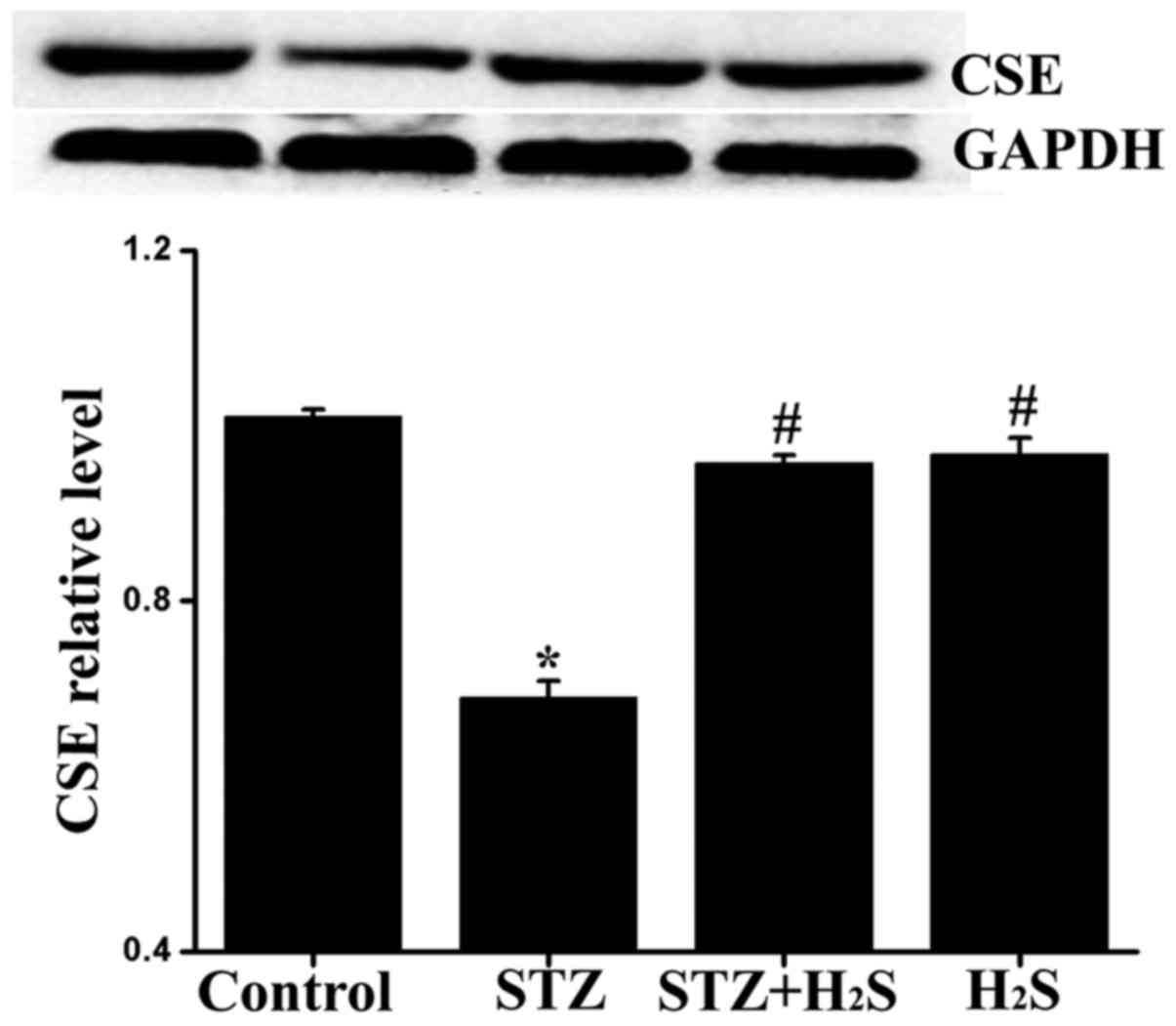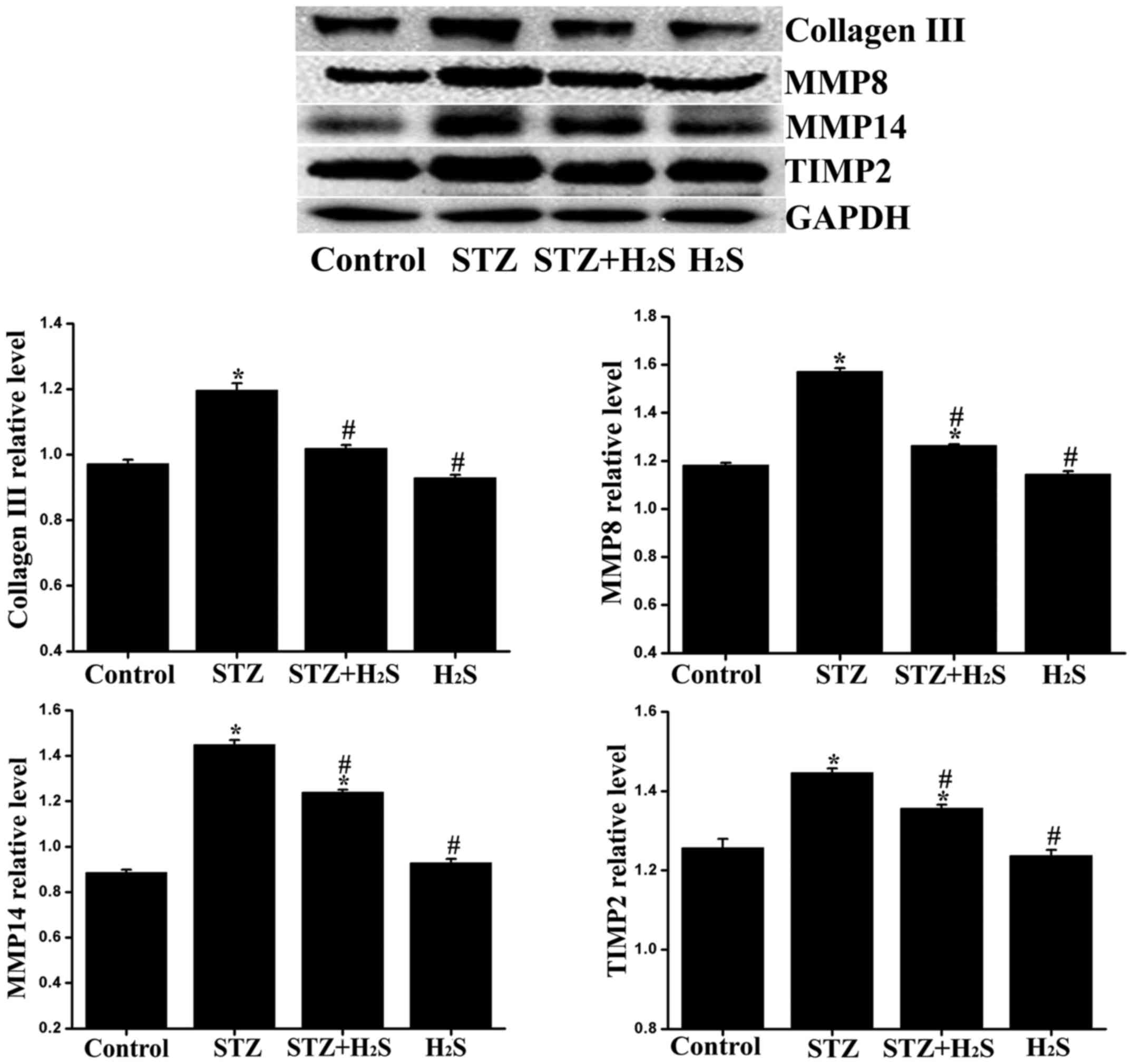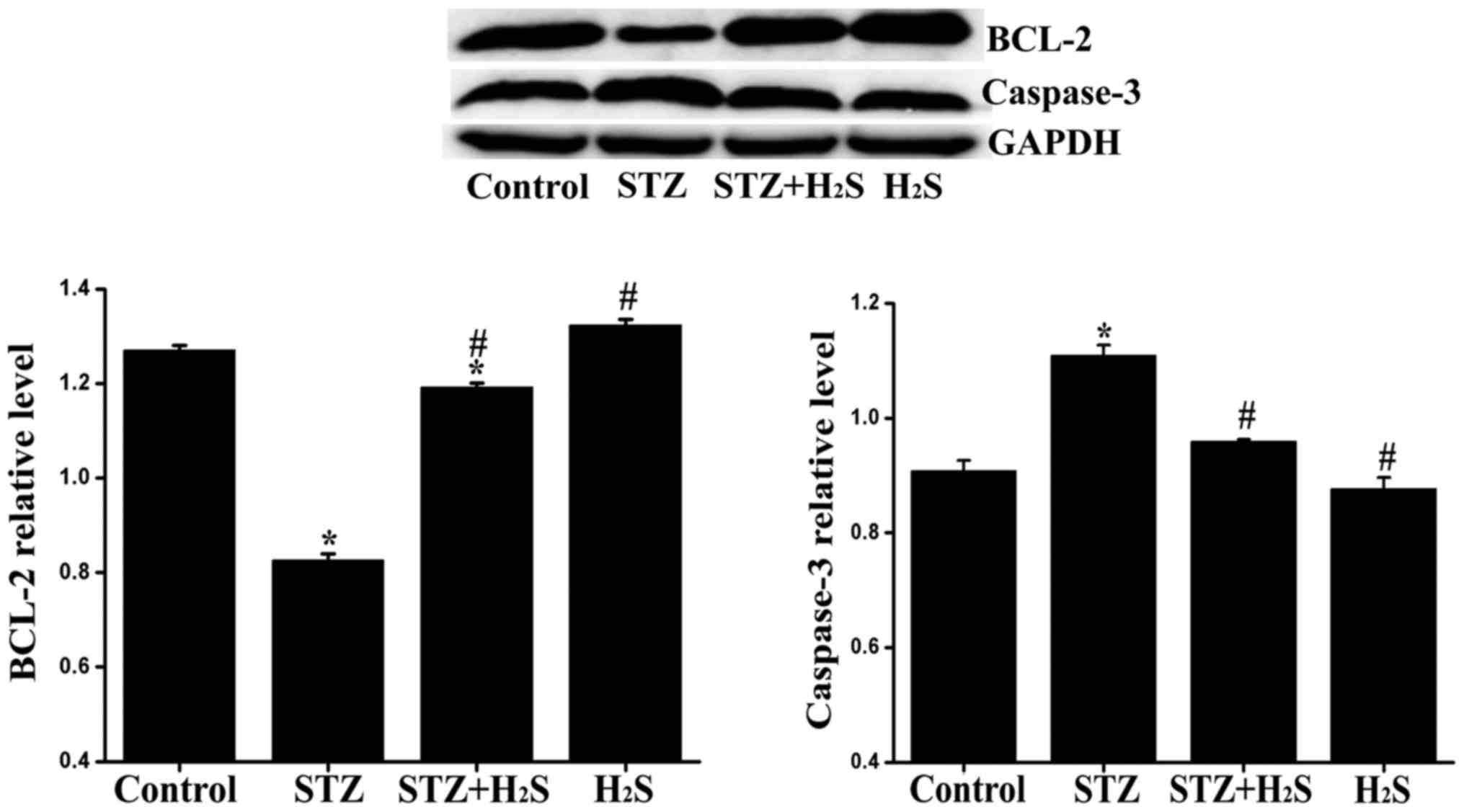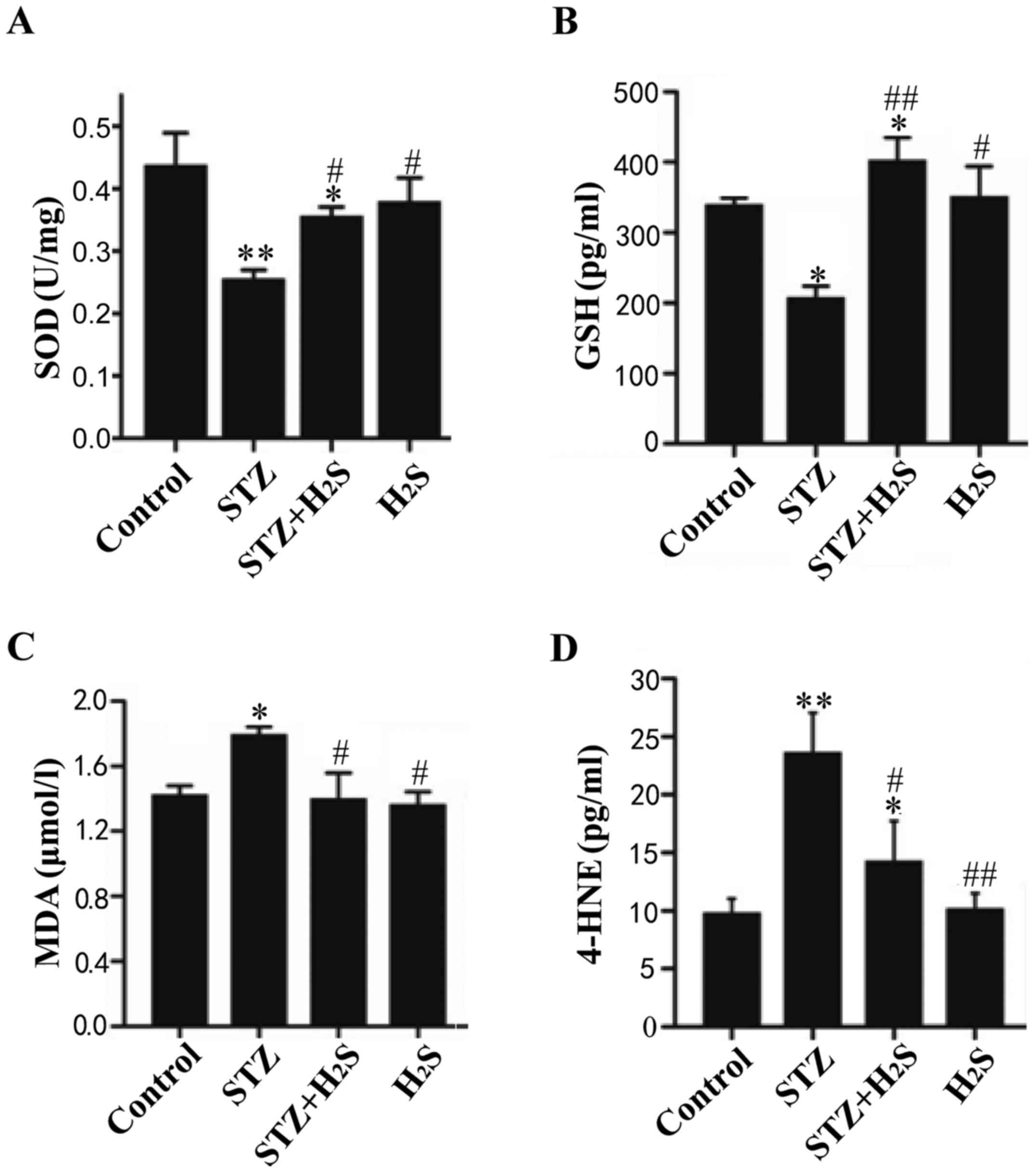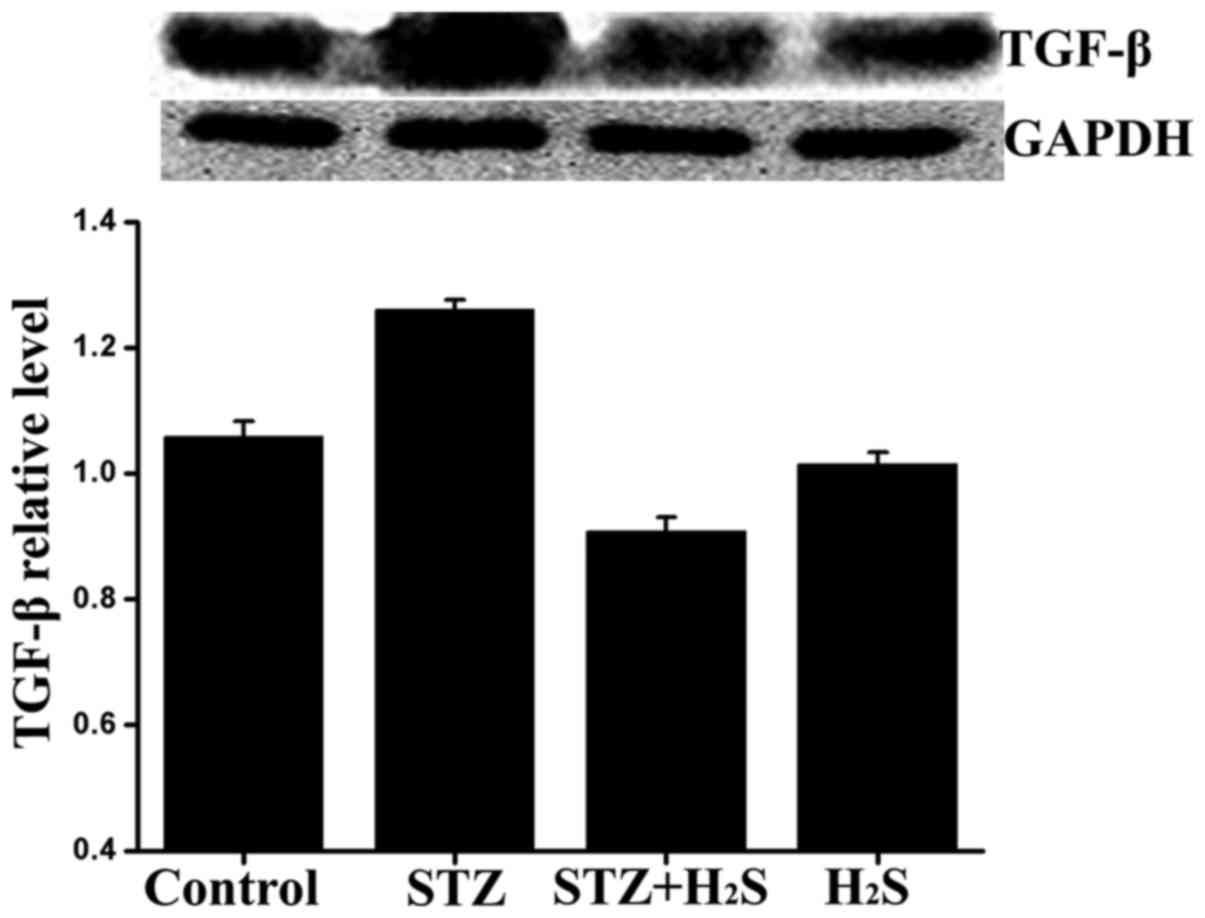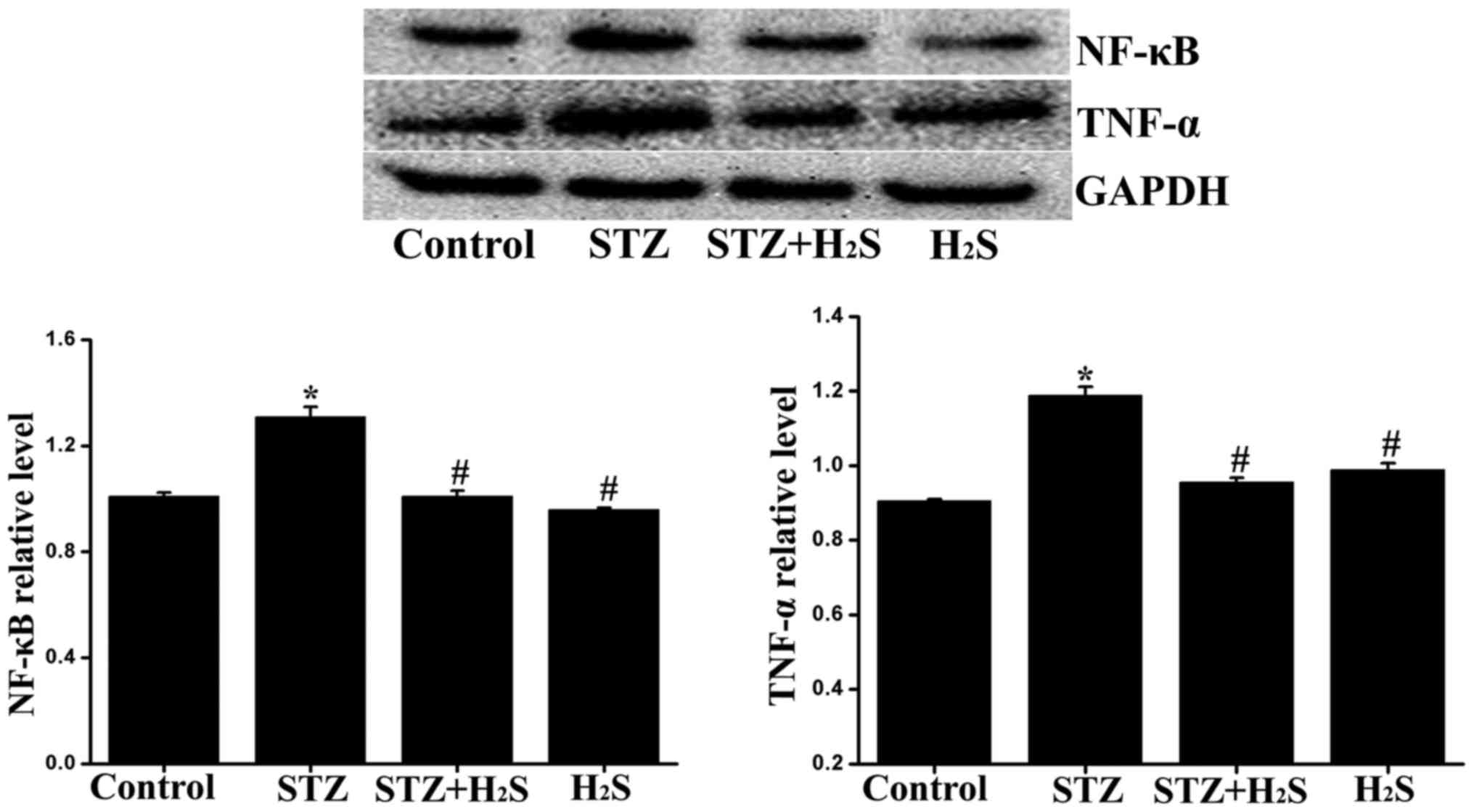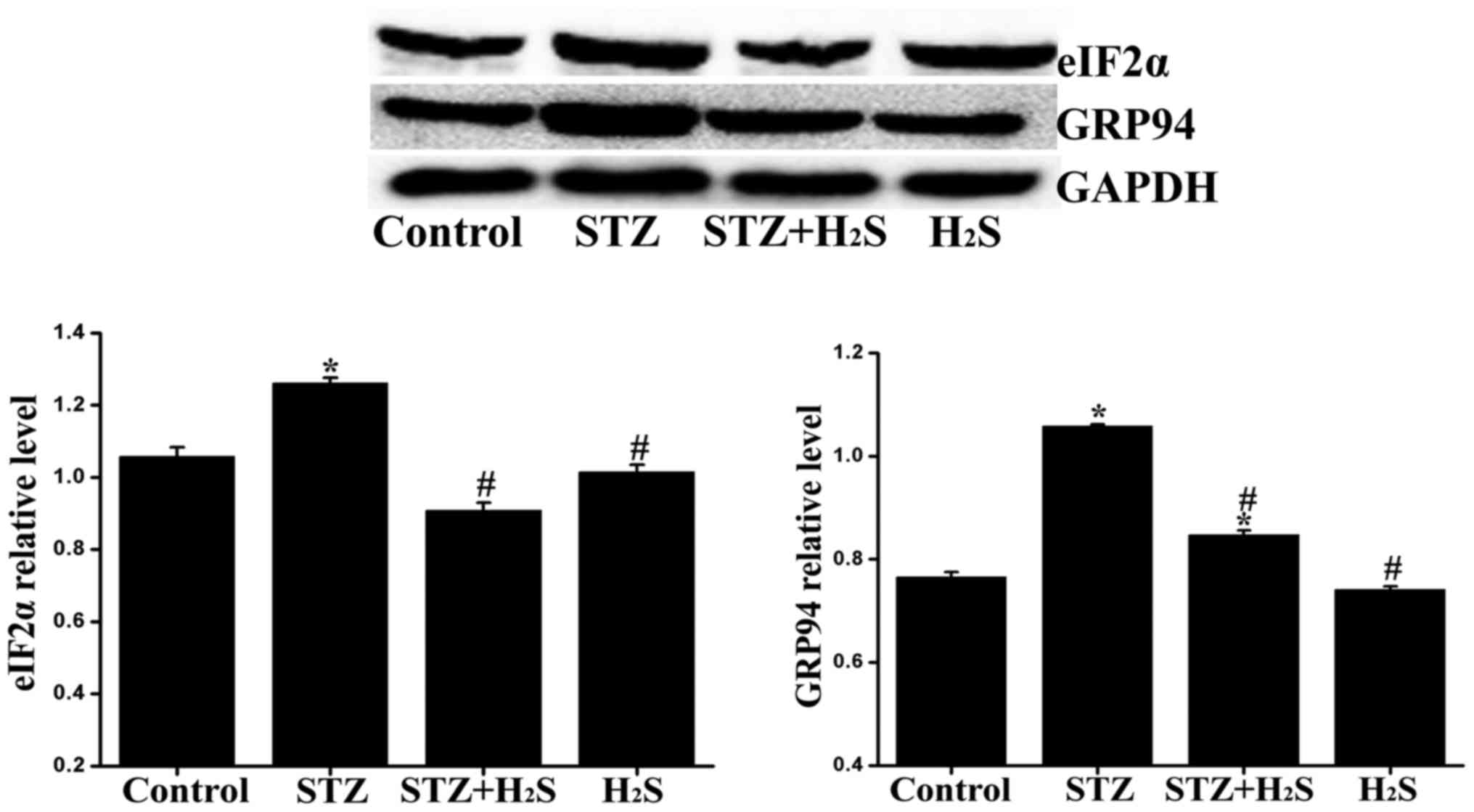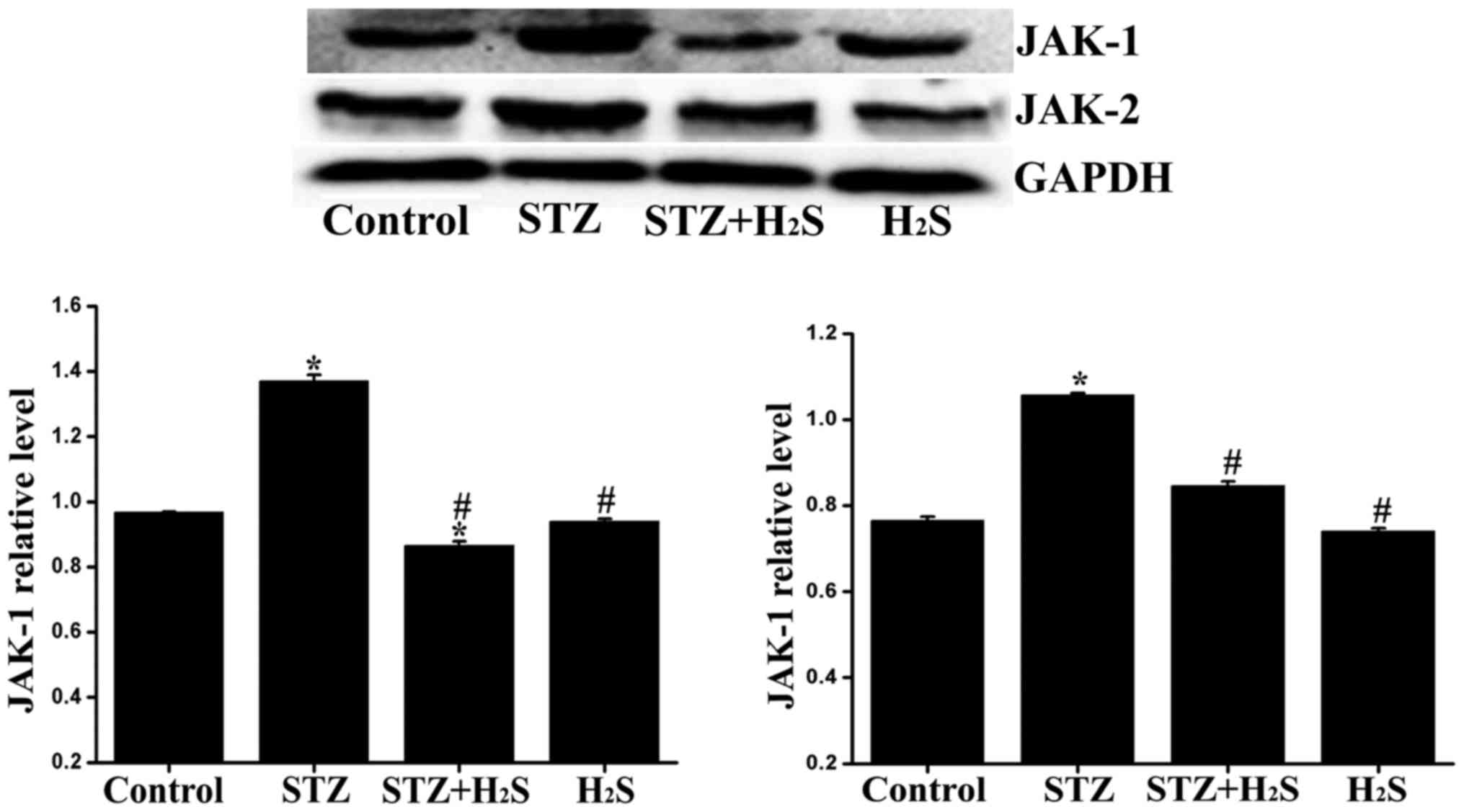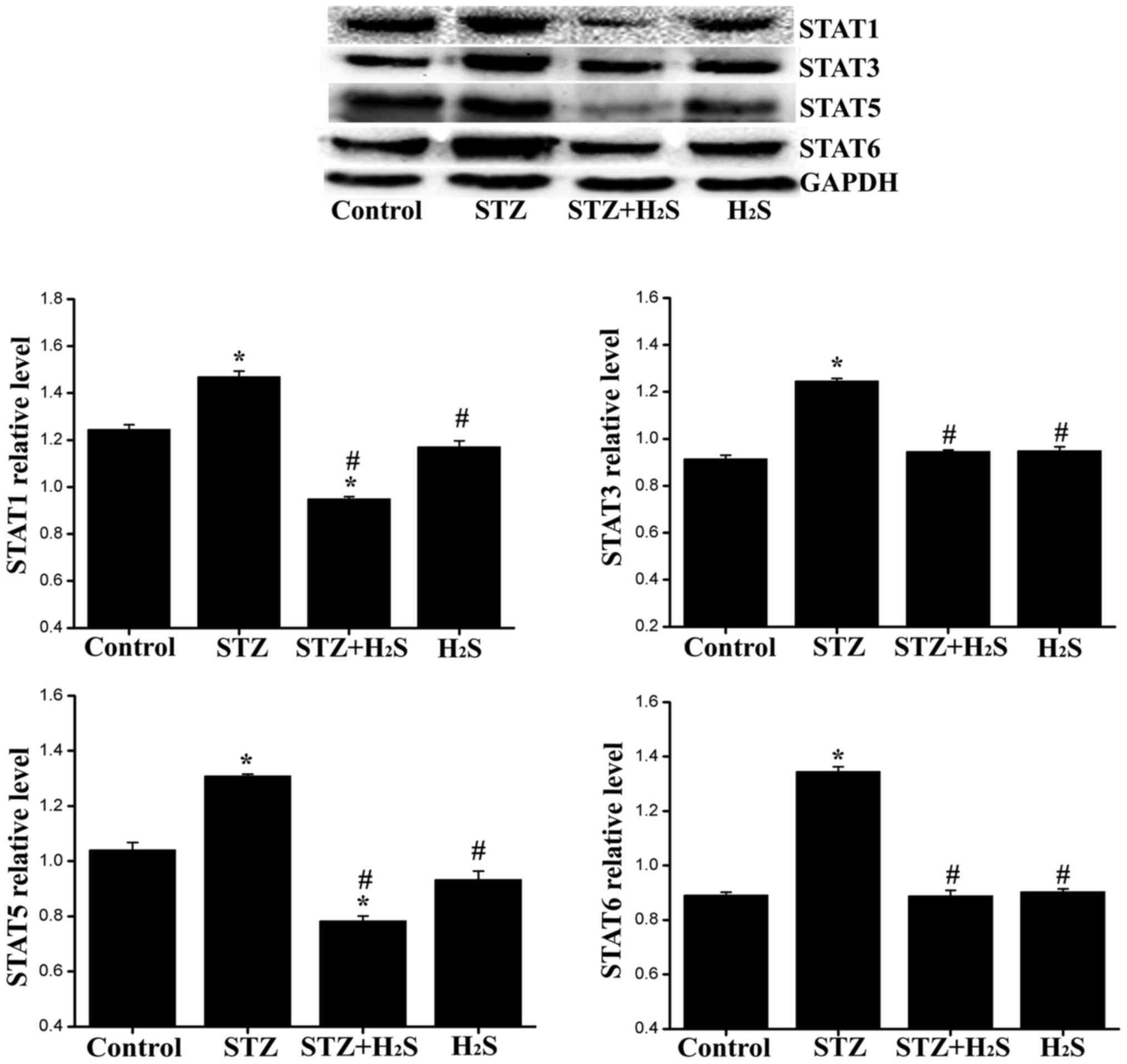Hydrogen sulfide attenuates myocardial fibrosis in diabetic rats through the JAK/STAT signaling pathway
- Authors:
- Published online on: January 23, 2018 https://doi.org/10.3892/ijmm.2018.3419
- Pages: 1867-1876
-
Copyright: © Liu et al. This is an open access article distributed under the terms of Creative Commons Attribution License.
Abstract
Introduction
With the improvement of living standards, nutrition-induced diabetes has become a global public health concern, representing the 5th leading cause of mortality worldwide (1). Diabetic cardiomyopathy (DCM) is a major diabetic complication (2). Cardiovascular complications of diabetes are the main cause of hospitalization and death. DCM is an independent complication of diabetes, characterized by early-onset diastolic dysfunction, which is largely attributed to myocardial fibrosis. DCM is a type of cardiomyopathy independent from the large vessels and coronary atherosclerosis, while 75% of patients with unexplained idiopathic dilated cardiomyopathy have been found to be diabetic (3). DCM is characterized by impaired myocardial insulin signaling, endoplasmic reticulum (ER) stress, mitochondrial dysfunction, activation of the sympathetic nervous system, excessive oxidative stress, increased inflammation, abnormal coronary microcirculation and maladaptive immune responses. These pathophysiological changes result in fibrosis, hypertrophy, cardiac diastolic/systolic dysfunction and, eventually, systolic heart failure. Cardiac interstitial fibrosis is a major characteristic of DCM (4), comprising overproduction and deposition of myocardial interstitial collagen and resulting in myocardial stiffness and cardiac dysfunction. A number of molecular mechanisms have been proposed to contribute to the development of DCM, including mechanisms involving oxidative stress, cell apoptosis, autophagy, increased inflammation and ER stress (5–7); however, the exact molecular mechanisms that trigger and drive these major pathological processes have yet to be fully elucidated.
Target organ damage in diabetes mellitus is associated with increased inflammation and oxidative stress, which are considered to be major factors contributing to the development and progression of DCM. The molecular mechanisms regulating related signal conduction remain largely unclear. Previous findings indicate that the activation of Janus kinase/signal transducer and activator of transcription (JAK/STAT) signaling is crucial for the occurrence and development of myocardial fibrosis. The JAK/STAT signaling pathway is a key point in the cytokine signal transduction pathways, as it regulates diverse pathophysiological processes, including proliferation, differentiation, apoptosis, cellular immunity and inflammation (8). Hydrogen sulfide (H2S) is a colorless, flammable gas with a characteristic odor, which, until recently, had been known to be an endogenously produced gaseous signaling molecule, similar to nitric oxide (NO) and carbon monoxide, and has been implicated in the regulation of inflammatory response, apoptosis, oxidative stress and angiogenesis (9). In addition, H2S has been shown to exert potent cytoprotective effects against tissue injury, including myocardial fibrosis (10). However, the specific mechanism of cardioprotection mediated by H2S in DCM remains largely unknown. There is little evidence on whether the JAK/STAT signaling pathway participates in the protection of exogenous H2S against myocardial fibrosis in diabetes mellitus. In the present study, sodium hydrosulfide (NaHS), an exogenous donor of H2S, was used to evaluate the antifibrotic, anti-inflammatory and antioxidant effects of H2S in the hearts of streptozotocin (STZ)-induced diabetic rats. The aim was to provide insight into the molecular mechanisms underlying the action of H2S in myocardial fibrosis associated with diabetes mellitus, improve our understanding of the pathophysiology of DCM, and enable the identification of new therapeutic targets based on the modulation of H2S production.
Materials and methods
Experimental animals
The experimental protocol was approved by the Animal Ethics Committee of the University of South China (Hengyang, China). A total of 40 adult male Sprague Dawley rats (weight, 300±20 g), which were provided by the SJA Animal Experimental Center of Changsha (Changsha, China), were bred in subcages in a clean laboratory with artificial lighting (12-h light/dark cycles), with free access to food and water.
Chemicals and reagents
NaHS was purchased from Sigma-Aldrich; Merck KGaA (St. Louis, MO, USA). STZ was purchased from MP Biomedicals, LLC (Santa Ana, CA, USA). Rabbit polyclonal anti-JAK-1 (cat. no. A00330), rabbit polyclonal anti-JAK-2 (cat. no. BA3398), rabbit polyclonal anti-collagen III (cat. no. BA0326), rabbit polyclonal anti-transforming growth factor (TGF)-β (cat. no. BA0290), rabbit polyclonal antitumor necrosis factor (TNF)-α (cat. no. BA14903), rabbit polyclonal anti-nuclear factor (NF)-κB (cat. no. BM3946), mouse anti-STAT1 (cat. no. BA0619-2), mouse anti-STAT3 (cat. no. BA0621), mouse anti-STAT5 (cat. no. BA1411), mouse anti-STAT6 (cat. no. BA1414), mouse anti-cystathionine-γ-lyase (CSE; cat. no. BA3605), mouse anti-tissue inhibitor of metalloproteinase (TIMP)2 (cat. no. BA0576), mouse anti-matrix metalloproteinase (MMP)8 (cat. no. BA2201), mouse anti-MMP14 (cat. no. BA1278) and rabbit polyclonal anti-glyceraldehyde 3-phosphate dehydrogenase (GAPDH; cat. no. BM3874), were all purchased from Wuhan Boster Biological Technology, Ltd. (Wuhan, China). The dilution ratio of these antibodies was 1:400. Furthermore, rabbit anti-eukaryotic initiation factor 2α (eIF2α; cat. no. 11233-1-AP), mouse anti-Bcl-2 (cat. no. 12789-1-AP), mouse anti-caspase-3 (cat. no. 19677-1-AP) and mouse anti-GRP94 (cat. no. 14700-1-AP) were all purchased from Proteintech Group, Inc. (Chicago, IL, USA). The dilution ratio of these antibodies was 1:1,000. Anti-rabbit secondary antibodies (cat. no. SA00001-2) were also purchased from Proteintech Group, Inc. The dilution ratio was 1:2,000. Cell lysis buffer for western blot analysis, the ELISA kit of superoxide dismutase (SOD), malondialdehyde (MDA), 4-hydroxynonenal (4-HNE), glutathione (GSH), the bicinchoninic acid (BCA) protein assay kit, the enhanced chemiluminescence reagent kit and the SDS-PAGE gel preparation kit were all obtained from Beyotime Institute of Biotechnology (Shanghai, China).
Model establishment and grouping
A total of 40 experimental animals were randomly divided into four groups (n=10) as follows: Normal (control group), diabetes mellitus (STZ group), diabetes mellitus treated with H2S (STZ + H2S group), and normal rats treated with H2S (H2S group). The STZ and STZ + H2S groups were administered intraperitoneal (i.p.) injections of STZ (40 mg/kg). During the same time, the rats of the control and H2S groups were treated with saline daily (i.p.). After 3 days of STZ injections, rat blood samples were collected through the caudal vein to measure the blood glucose level. Blood glucose >16.7 mmol/l suggested successful establishment of the diabetes model. Subsequently, NaHS (100 µmol/kg, i.p.) was administered to the rats of the STZ + H2S and H2S groups, whereas rats in the control and STZ groups were treated with phosphate-buffered saline daily. The experiment lasted for 8 weeks. The rats were sacrificed following anesthesia with chloral hydrate (350 mg/kg) and all the animals were weighed. The hearts of the rats were lavaged with ice-cold normal saline before removing and weighing. Three rats were selected randomly from each group. Each heart was divided into two parts, one of which was utilized for terminal deoxynucleotidyl transferase dUTP nick end labeling (TUNEL) assay and the other for biochemical analyses.
Histopathological analysis of myocardial fibers
The removed hearts were fixed in 4% paraformaldehyde. Each heart was dehydrated with graded alcohols, embedded in paraffin and sliced into 5-µm sections. These sections were stained using a hematoxylin and eosin (H&E) staining kit and a Masson's trichrome staining kit, and observed under a light microscope at a magnification of ×200.
TUNEL assay
The rat myocardial tissue sections were fixed in 10% formalin, embedded in paraffin and processed for the TuNEL assay. The slides were treated with H2O2 and incubated with a reaction mixture containing TdT and digoxigenin-conjugated duTP for 1 h at 37°C. Labeled DNA was visualized with peroxidase-conjugated anti-digoxigenin antibody using 3,3′-diaminobenzidine as the chromogen. Rat testicular tissue was used as positive control in the TUNEL assay.
Measurement of MDA, 4-HNE, GSH and SOD
The content of MDA, 4-HNE and GSH and the activity of SOD in the heart were assayed by ELISA. The ELISA kits for SOD, MDA, 4-HNE and GSH were all obtained from Beyotime Institute of Biotechnology. The steps were conducted following the manufacturer's instructions.
Western blot analysis
Total protein was extracted in ice-cold radioimmunoprecipitation assay buffer containing protease inhibitors (Beyotime Institute of Biotechnology), and quantified using a BCA protein assay kit. Proteins were denatured, separated by SDS-PAGE electrophoresis and transferred to a PVDF membrane by the wet transfer method. The membranes were blocked with 5% skimmed milk in Tris-buffered saline with Tween-20 (TBST) for 2 h at room temperature and incubated with blocking solution containing primary antibody (1:400, anti-collagen III; 1:400, anti-MMP8; 1:400, anti-MMP14; 1:400, anti-TIMP2; 1:400, anti-CSE; 1:400, anti-TGF-β; 1:400, anti-TNF-α; 1:400, anti-NF-κB; 1:400, anti-STAT1/3/5/6; 1:400, anti-JAK-1/2; 1:1,000, anti-eIF2α; 1:1,000, anti-GRP94; 1:1,000, anti-caspase-3; and 1:1,000, anti-Bcl-2) overnight at 4°C. After washing three times with TBST, the membranes were incubated with horseradish peroxidase-conjugated secondary antibody (1:2,000) for 1 h at room temperature. Next, the membranes were washed in TBST buffer three times and subjected to chemiluminescence detection assay. The bands were analyzed with a Molecular Imager VersaDoc MP 5000 system (Bio-Rad Laboratories, Inc., Hercules, CA, USA).
Statistical analysis
Data are expressed as mean ± standard deviation. Statistical differences among the groups were assessed by one-way analysis of variance with SPSS 18.0 software (SPSS Inc., Chicago, IL, USA). Differences between two groups were analyzed using the Student-Newman-Keuls test. P<0.05 was considered to indicate a statistically significant difference.
Results
Effects of H2S on blood glucose concentration, body weight (BW) and heart weight (HW) in diabetic rats
Plasma glucose concentration, BW and HW were measured prior to sacrificing the rats. The results revealed that BW and HW in the STZ-treated groups were significantly lower compared with those in the control group. The concentration of blood glucose was significantly increased in the STZ-treated group compared with that in the control group. However, no significant differences in BW, HW or blood glucose concentration were observed between the H2S-treated and STZ groups (Table I).
Effects of H2S on CSE expression in diabetic rats
To determine whether diabetes-induced myocardial damage was associated with decreased generation of endogenous H2S, the expression level of CSE was measured by western blot analysis. Compared with the control group, the expression level of CSE in the STZ and STZ + H2S groups was significantly decreased, while there was no obvious difference in the H2S group; compared with the STZ group, the myocardial expression of CSE was significantly increased in the STZ + H2S and H2S groups (Fig. 1).
H2S improves histological changes in rats treated with STZ
On examination under a light microscope, myocardial cells in the control group were orderly and compactly arranged, the intercellular space was normal, and there was less extracellular matrix. Compared with the control group, the cardiomyocytes in the STZ group were disordered, the intercellular spaces were broader, and interstitial fibrosis was present. However, these changes were markedly reversed in the STZ + H2S group. In the H2S group, the myocardial tissue structure and arrangement of fibers were similar to those of the control group (Fig. 2). Masson's staining revealed the deposition of collagen fibers (blue staining), reflecting the extent of myocardial fibrosis. As demonstrated by Masson's staining, there was little evidence of myocardial fibrosis in the control group. However, a significantly increased degree of fibrosis was observed in the STZ group. Compared with the STZ group, myocardial fibrosis was markedly improved in the STZ + H2S group; however, compared with the control group, there were no significant histological changes in the H2S group (Fig. 3).
Effects of H2S on collagen III, MMP8, MMP14 and TIMP2 expression in diabetic rats
As the balance of MMPs/TIMPs determines the ratio of collagen synthesis and degradation, it may reflect the status of fibrosis to a certain extent. Therefore, the expression of collagen III, MMP8, MMP14 and TIMP2 was determined. Compared with the control group, the expression levels of collagen III, MMP8, MMP14 and TIMP2 were significantly increased in the STZ group, and the expression levels of TIMP2, MMP8 and MMP14 were significantly increased in the STZ + H2S group. Compared with the STZ group, the myocardial expression of collagen III, MMP8, MMP14 and TIMP2 was significantly reduced in the STZ + H2S group. No significant difference was observed in the expression levels of collagen III, MMP8, MMP14 and TIMP2 between the control and H2S groups (Fig. 4).
H2S reduces cardiomyocyte apoptosis in diabetic rats
In the present study, the TUNEL assay was used to detect apoptosis in heart tissue. The number of apoptotic cells was obviously higher in the STZ group compared with that in the control group. However, the number of TUNEL-positive cells was found to be decreased in the STZ + H2S group. No significant difference was observed between the control and H2S groups (Fig. 5).
Effects of H2S on Bcl-2 and caspase-3 expression in diabetic rats
It is widely accepted that Bcl-2 and caspase-3 are closely associated with apoptosis. In our experiment, the expression of Bcl-2 and caspase-3 was determined by western blot analysis. Compared with the control group, the expression level of caspase-3 was significantly increased in the STZ group, and the expression level of Bcl-2 was significantly decreased in the STZ and STZ + H2S groups. Compared with the STZ group, the myocardial expression of caspase-3 was significantly reduced, whereas that of Bcl-2 was significantly increased in the STZ + H2S and H2S groups. No significant difference was observed in the expression levels of Bcl-2 and caspase-3 between the control and H2S groups (Fig. 6).
Protein expression levels of MDA, 4-HNE, GSH and SOD
The levels of GSH, SOD, 4-HNE and MDA were measured to assess oxidative damage in the myocardium and determine whether H2S protects against this type of damage. Compared with the control group, the expression levels of SOD and GSH were significantly decreased in the STZ group, whereas the expression level of SOD was significantly decreased and that of GSH was significantly increased in the STZ + H2S group (Fig. 7A and B). Compared with the STZ group, the myocardial expression of SOD and GSH was significantly increased in the STZ + H2S and H2S groups. In addition, the levels of MDA and 4-HNE in STZ group rats were obviously higher compared with those in the control group. Compared with the STZ group, the myocardial expression of MDA and 4-HNE was significantly reduced in the STZ + H2S and H2S groups (Fig. 7C and D). No significant difference was observed in the expression levels of SOD, GSH, MDA and 4-HNE between the control and H2S groups.
Effects of H2S on TGF-β expression in diabetic rats
It is widely accepted that TGF-β is closely associated with fibrogenesis. In our experiment, the expression of TGF-β was determined by western blot analysis. Compared with the control group, the expression level of TGF-β was significantly higher in the STZ group and significantly lower in the STZ + H2S group, while there was no obvious difference between the control and H2S groups. Compared with the STZ group, the myocardial expression of TGF-β was significantly reduced in the STZ + H2S group (Fig. 8).
Effects of H2S on TNF-α and NF-κB expression in diabetic rats
The expression levels of TNF-α and NF-κB were measured to assess inflammatory response using western blot analysis. Compared with the control group, the expression levels of TNF-α and NF-κB were significantly increased in the STZ group, the expression level of TNF-α was significantly decreased in the STZ + H2S group, while there was no significant difference between the control and H2S groups. Compared with the STZ group, the myocardial expression of TNF-α and NF-κB were significantly reduced in the STZ + H2S group (Fig. 9).
Effects of H2S on eIF2α and GRP94 expression in diabetic rats
The expression of eIF2α and GRP94 was determined by western blot analysis to assess ER stress in the myocardium. Compared with the control group, the expression levels of eIF2α and GRP94 were significantly increased in the STZ group and the expression of GRP94 was significantly increased in the STZ + H2S group. Compared with the STZ group, the myocardial expression of eIF2α and GRP94 was significantly reduced in the STZ + H2S group. No significant difference was observed in the expression levels of eIF2α and GRP94 between the control and H2S groups (Fig. 10).
Administration of exogenous H2S donor affects JAK-1/2 and STAT1/3/5/6 signaling
To further explore the potential signaling pathway involved in diabetes, proteins associated with the JAK/STAT pathway were detected by western blot analysis. Compared with the control group, the expression level of JAK-1/2 in the STZ group was markedly increased, the expression level of JAK-1 in the STZ + H2S group was significantly decreased, and the expression levels of JAK-2 in STZ + H2S group was significantly increased. Compared with the STZ group, the myocardial expression of JAK-1/2 exhibited a marked reduction in the STZ + H2S group. No significant difference was observed in the expression levels of JAK-1 and -2 between the control and H2S groups (Fig. 11). Compared with the control group, the expression levels of STAT1/3/5/6 in the STZ group were significantly increased. Compared with the STZ group, the myocardial expression of STAT1/3/5/6 was significantly reduced in the STZ + H2S group. No significant difference was observed in the expression levels of STAT1/3/5/6 between the control and H2S groups (Fig. 12).
Discussion
Over the past two decades, the worldwide incidence of diabetes mellitus has steadily increased as a consequence of higher rates of obesity and changes in lifestyle. If unaddressed, nearly half a billion individuals will suffer from diabetes mellitus in 2030 (11). Diabetes is associated with a number of fatal complications, such as DCM, which accounts for most of the morbidity and mortality in this population and represents a major global health concern (12).
Cardiac interstitial fibrosis, as a major characteristic of DCM, results from the overproduction and deposition of myocardial interstitial collagen, leading to hypertrophy, myocardial stiffness, cardiac diastolic/systolic dysfunction and, eventually, heart failure (13). The results of immunohistochemical analysis revealed obvious interstitial fibrosis in the myocardium of diabetic rats. Compared with the control group, the arrangement of myocardial cells was markedly disordered, and collagen deposition in cardiac extracellular matrix was increased in the STZ group. The expression of collagen III in the myocardium was also significantly increased in the STZ group. The results of H&E and Masson's staining in the present study also demonstrated that diabetes increased the relative disorganization of myocardial cells and enhanced deposition of collagen in the STZ group, clearly indicating that myocardial damage was caused by diabetes. Furthermore, hyperglycemia induced an increase in the heart-to-body weight (HW/BW) ratio. In addition, the results of the present study demonstrated that there was a deregulation of MMPs/TIMPs expression in the myocardial tissue of diabetic rats. All the abovementioned results suggest that there was obvious cardiac interstitial fibrosis in diabetic rats.
Numerous mechanisms may collectively contribute to the development of DCM, including oxidative stress, insulin resistance, myocardial inflammation and ER stress (14,15). However, the exact molecular mechanisms that trigger and fuel these major pathological processes are not entirely clear. An increasing number of clinical and experimental studies indicate that sustained hyperglycemia results in reduced antioxidant capacity and increased oxidative stress that are involved in development of diabetes and its complications (16–18). Inflammation is currently recognized as a key contributor to the pathogenesis of diabetes and its cardiovascular complications (19–21), and the diabetic myocardium exhibits increased levels of proinflammatory cytokines, such as TNF-α and IL-6 (22). Increased oxidative stress is another common characteristic in models of DCM. Oxidative stress indicates a severe imbalance between the generation of reactive oxygen species (ROS) and their clearance by antioxidant defense systems, which make the heart highly susceptible to oxidative damage (23,24). ROS may induce lipid peroxidation and result in the increased expression of MDA and 4-HNE. There are natural detoxification molecules in the heart that reduce or scavenge ROS, such as SOD and GSH. ROS, as the main inducer of oxidative stress in vivo, may also result in cell apoptosis. Accordingly, ROS and oxidative stress play an important role in the occurrence and development of diabetic cardiovascular complications (25,26). In the present study, oxidative stress was evaluated through detecting the content of MDA, 4-HNE, GSH and SOD in myocardial cells by ELISA. The expression of collagen III, MMP8, MMP14, TIMP2, TGF-β, CSE, eIF2α, GRP94, Bcl-2, caspase-3, TNF-α, NF-κB, JAK-1/2 and STAT1/3/5/6 was analyzed by western blotting and the results demonstrated that the expression of MDA, 4-HNE, TNF-α, NF-κB, TGF-β, eIF2α, GRP94 and caspase-3 was significantly increased in the STZ group, and the expression of SOD, GSH and Bcl-2 was markedly decreased in the STZ group. These results suggest that there was significantly increased oxidative stress in the myocardium of diabetic rats. Furthermore, there was overactivation of ER stress pathways. Inflammatory factors, such as TNF-α, NF-κB and TGF-β, were also significantly increased. In the STZ group, the extent of myocardial tissue damage gradually increased, along with a significantly increased apoptotic cell rate, demonstrating that cells failed to repair themselves. The result of the TUNEL assay revealed that, compared with the control group, there was a significantly increased number of apoptotic cells in the myocardium of diabetic rats. The expression of caspase-3 was significantly upregulated in the myocardium of diabetic rats, while that of Bcl-2 was significantly downregulated.
ER stress is an adaptive response of cells to ischemia, hypoxia and hyperglycemia (27,28). Oxidative stress may lead to ER stress (29), and GRP94 and eIF2α are classic markers of ER stress. Consistent with previous studies (30,31), the expression of GRP94 and eIF2α in the myocardium of diabetic rats were obviously upregulated in the present study, suggesting the presence of excessive ER stress. TGF-β1 is currently considered as one of the most important factors promoting myocardial fibrosis and is considered to play an important role in this process (32). It has been suggested that TGF-β1 plays a key role in myocardial interstitial fibrosis in DCM (33). In our experiments, the TGF-β1 expression in the myocardium of rats with DCM was significantly higher compared with that in control rats, and was positively correlated with the content of collagen; thus, TGF-β may be involved in the regulation and crosstalk of oxidative stress, ER stress, inflammation and apoptosis of cardiomyocytes.
The JAK/STAT signaling pathway is an important cytokine signal transduction pathway and a pleiotropic cascade that is crucial for cytokine and growth hormone receptor signaling, and regulates diverse physiological and pathological processes, including proliferation, differentiation, apoptosis and inflammation (34). In the present study, the expression of GRP94 and eIF2α in the myocardium of diabetic rats were found to be obviously upregulated, suggesting the presence of excessive ER stress. The activation of the JAK/STAT signal transduction pathway may upregulate the expression of TGF-β and type I and III collagens, leading to the occurrence of fibrosis (35,36). It was recently demonstrated that the exposure of glomerular mesangial cells to high glucose caused the activation of JAK-2, STAT1, STAT3 and STAT5, along with an increase in TGF-β1 and fibronectin synthesis (37). Conversely, it was reported that inhibiting JAK/STAT signaling in mesangial cells cultured in high glucose may decrease the synthesis of TGF-β1 and fibrin (38). The JAK/STATs signal transduction pathway is closely associated with myocardial fibrosis and cardiac hypertrophy caused by pressure overload, heart failure and cardiac dysfunction induced by ischemia-reperfusion (8). In our study, the expression levels of JAK-1, JAK-2 and STATs were significantly upregulated in rats of the STZ group compared with control rats, and the relative contents of JAK-1/2 and STATs were positively correlated with the content of collagen and the expression of TGF-β1 in the myocardium. It is suggested that high glucose or glycosylated products in diabetes induce oxidative stress to produce inflammatory cytokines followed by the activation of JAK/STAT and TGF-β signaling.
H2S is an endogenously produced gaseous molecule that plays an important role in cellular signaling and possesses potent anti-inflammatory, antioxidant, and other regulatory properties (39,40). In addition, H2S has been shown to exert potent cytoprotective effects against tissue injury as well as antifibrotic effects, including prevention of myocardial fibrosis (41). The reported cytoprotective effects of H2S are partially associated with its ability to neutralize ROS, reduce apoptotic signaling, and reversibly modulate mitochondrial respiration (42). However, the association between H2S and JAK/STAT signaling remains unclear. Our results demonstrated that the expression level of CSE was significantly downregulated in rats of the DCM group compared with control rats, suggesting that diabetes impairs the expression of endogenous H2S/CSE. It was observed that, compared with the rats in the STZ group, the expression of MDA, 4-HNE, TNF-α, NF-κB, TGF-β, eIF2α, GRP94 and caspase-3 was significantly downregulated and the expression of SOD, GSH and Bcl-2 was significantly higher in the myocardium of rats treated with the H2S donor NaHS. The levels of JAK-1/2 and STATs were lower, the expression of TGF-β1 was downregulated, the content of collagen in the myocardium decreased, and the level of myocardial fibrosis was visibly reduced in the myocardium of rats in the STZ + H2S group. H2S was able to attenuate matrix deposition and myocardial fibrosis, reduce apoptosis, alleviate inflammation, improve the deregulation of MMPs/TIMPs, and inhibit excessive oxidative stress and ER stress in the myocardium of diabetic rats. The protective mechanism of H2S against diabetic myocardial fibrosis may be associated with the downregulation of JAK/STAT and TGF-β1 signaling. These findings indicate that H2S exerts a protective effect against myocardial interstitial fibrosis in DCM by downregulating JAK/STAT signaling.
Moreover, these results suggest that H2S, acts as a scavenger of ROS, enhances the endogenous antioxidant defenses and creates an environment resistant to oxidative stress in the myocardium of diabetic rats. Another major finding of the present study is that the JAK/STAT signaling pathway plays an important role in mediating the cardioprotective effects of H2S. To date, it has not been fully elucidated how H2S exerts its beneficial effect against cardiac fibrosis under diabetic conditions via the JAK/STAT signaling pathway. However, as H2S attenuates diabetes-induced oxidative damage and the subsequent cardiac fibrosis, it appears to be a promising novel therapeutic strategy for the prevention and treatment of DCM.
Glossary
Abbreviations
Abbreviations:
|
H2S |
hydrogen sulfide |
|
NaHS |
sodium hydrosulfide |
|
DCM |
diabetic cardiomyopathy |
|
CSE |
cystathionine-γ-lyase |
|
MDA |
malondialdehyde |
|
4-HNE |
4-hydroxynonenal |
|
GSH |
glutathione |
|
SOD |
superoxide dismutase |
|
STZ |
streptozotocin |
|
MMPs |
matrix metalloproteinases |
|
CRP |
C-reactive protein |
|
eIF2α |
eukaryotic initiation factor 2α |
Acknowledgments
The present study was supported by the National Natural Science Foundation of China (grant nos. 81202830 and 81270181).
Notes
[1] Competing interests
The authors declare that they have no competing interests.
References
|
Yang W, Lu J, Weng J, Jia W, Ji L, Xiao J, Shan Z, Liu J, Tian H, Ji Q, et al China National Diabetes and Metabolic Disorders Study Group: Prevalence of diabetes among men and women in China. N Engl J Med. 362:1090–1101. 2010. View Article : Google Scholar : PubMed/NCBI | |
|
Bell DS: Diabetic cardiomyopathy. Diabetes Care. 26:2949–2951. 2003. View Article : Google Scholar : PubMed/NCBI | |
|
Asbun J and Villarreal FJ: The pathogenesis of myocardial fibrosis in the setting of diabetic cardiomyopathy. J Am Coll Cardiol. 47:693–700. 2006. View Article : Google Scholar : PubMed/NCBI | |
|
Bugger H and Abel ED: Molecular mechanisms of diabetic cardiomyopathy. Diabetologia. 57:660–671. 2014. View Article : Google Scholar : PubMed/NCBI | |
|
Thandavarayan RA, Giridharan VV, Watanabe K and Konishi T: Diabetic cardiomyopathy and oxidative stress: role of antioxidants. Cardiovasc Hematol Agents Med Chem. 9:225–230. 2011. View Article : Google Scholar : PubMed/NCBI | |
|
Kumar S, Prasad S and Sitasawad SL: Multiple antioxidants improve cardiac complications and inhibit cardiac cell death in streptozotocin-induced diabetic rats. PLoS One. 8:e670092013. View Article : Google Scholar : PubMed/NCBI | |
|
Varga ZV, Giricz Z, Liaudet L, Haskó G, Ferdinandy P and Pacher P: Interplay of oxidative, nitrosative/nitrative stress, inflammation, cell death and autophagy in diabetic cardiomyopathy. Biochim Biophys Acta. 1852:232–242. 2015. View Article : Google Scholar | |
|
Kiu H and Nicholson SE: Biology and significance of the JAK/STAT signalling pathways. Growth Factors. 30:88–106. 2012. View Article : Google Scholar : PubMed/NCBI | |
|
Kimura H: Production and physiological effects of hydrogen sulfide. Antioxid Redox Signal. 20:783–793. 2014. View Article : Google Scholar : | |
|
Lavu M, Bhushan S and Lefer DJ: Hydrogen sulfide-mediated cardioprotection: mechanisms and therapeutic potential. Clin Sci (Lond). 120:219–229. 2011. View Article : Google Scholar | |
|
Wild S, Roglic G, Green A, Sicree R and King H: Global prevalence of diabetes: estimates for the year 2000 and projections for 2030. Diabetes Care. 27:1047–1053. 2004. View Article : Google Scholar : PubMed/NCBI | |
|
Chen Y, Du J, Zhao YT, Zhang L, Lv G, Zhuang S, Qin G and Zhao TC: Histone deacetylase (HDAC) inhibition improves myocardial function and prevents cardiac remodeling in diabetic mice. Cardiovasc Diabetol. 14:992015. View Article : Google Scholar : PubMed/NCBI | |
|
Falcão-Pires I and Leite-Moreira AF: Diabetic cardiomyopathy: understanding the molecular and cellular basis to progress in diagnosis and treatment. Heart Fail Rev. 17:325–344. 2012. View Article : Google Scholar | |
|
Yang L, Zhao D, Ren J and Yang J: Endoplasmic reticulum stress and protein quality control in diabetic cardiomyopathy. Biochim Biophys Acta. 1852:209–218. 2015. View Article : Google Scholar | |
|
Jia G, DeMarco VG and Sowers JR: Insulin resistance and hyperinsulinaemia in diabetic cardiomyopathy. Nat Rev Endocrinol. 12:144–153. 2016. View Article : Google Scholar : | |
|
Sun X, Chen RC, Yang ZH, Sun GB, Wang M, Ma XJ, Yang LJ and Sun XB: Taxifolin prevents diabetic cardiomyopathy in vivo and in vitro by inhibition of oxidative stress and cell apoptosis. Food Chem Toxicol. 63:221–232. 2014. View Article : Google Scholar | |
|
Zhao Y, Zhang L, Qiao Y, Zhou X, Wu G, Wang L, Peng Y, Dong X, Huang H and Si L: Heme oxygenase-1 prevents cardiac dysfunction in streptozotocin-diabetic mice by reducing inflammation, oxidative stress, apoptosis and enhancing autophagy. PLoS One. 8:e759272013. View Article : Google Scholar : PubMed/NCBI | |
|
Taye A, Abouzied MM and Mohafez OM: Tempol ameliorates cardiac fibrosis in streptozotocin-induced diabetic rats: role of oxidative stress in diabetic cardiomyopathy. Naunyn Schmiedebergs Arch Pharmacol. 386:1071–1080. 2013. View Article : Google Scholar : PubMed/NCBI | |
|
Malfitano C, Alba Loureiro TC, Rodrigues B, Sirvente R, Salemi VM, Rabechi NB, Lacchini S, Curi R and Irigoyen MC: Hyperglycaemia protects the heart after myocardial infarction: aspects of programmed cell survival and cell death. Eur J Heart Fail. 12:659–667. 2010. View Article : Google Scholar : PubMed/NCBI | |
|
Van Linthout S, Riad A, Dhayat N, Spillmann F, Du J, Dhayat S, Westermann D, Hilfiker-Kleiner D, Noutsias M, Laufs U, et al: Anti-inflammatory effects of atorvastatin improve left ventricular function in experimental diabetic cardiomyopathy. Diabetologia. 50:1977–1986. 2007. View Article : Google Scholar : PubMed/NCBI | |
|
Westermann D, Walther T, Savvatis K, Escher F, Sobirey M, Riad A, Bader M, Schultheiss HP and Tschöpe C: Gene deletion of the kinin receptor B1 attenuates cardiac inflammation and fibrosis during the development of experimental diabetic cardiomyopathy. Diabetes. 58:1373–1381. 2009. View Article : Google Scholar : PubMed/NCBI | |
|
Westermann D, Van Linthout S, Dhayat S, Dhayat N, Schmidt A, Noutsias M, Song XY, Spillmann F, Riad A, Schultheiss HP, et al: Tumor necrosis factor-alpha antagonism protects from myocardial inflammation and fibrosis in experimental diabetic cardiomyopathy. Basic Res Cardiol. 102:500–507. 2007. View Article : Google Scholar : PubMed/NCBI | |
|
Yu W, Zha W, Guo S, Cheng H, Wu J and Liu C: Flos Puerariae extract prevents myocardial apoptosis via attenuation oxidative stress in streptozotocin-induced diabetic mice. PLoS One. 9:e980442014. View Article : Google Scholar : PubMed/NCBI | |
|
Giacco F and Brownlee M: Oxidative stress and diabetic complications. Circ Res. 107:1058–1070. 2010. View Article : Google Scholar : PubMed/NCBI | |
|
Frustaci A, Kajstura J, Chimenti C, Jakoniuk I, Leri A, Maseri A, Nadal-Ginard B and Anversa P: Myocardial cell death in human diabetes. Circ Res. 87:1123–1132. 2000. View Article : Google Scholar : PubMed/NCBI | |
|
Yaras N, Sariahmetoglu M, Bilginoglu A, Aydemir-Koksoy A, Onay-Besikci A, Turan B and Schulz R: Protective action of doxycycline against diabetic cardiomyopathy in rats. Br J Pharmacol. 155:1174–1184. 2008. View Article : Google Scholar : PubMed/NCBI | |
|
Tajiri S, Oyadomari S, Yano S, Morioka M, Gotoh T, Hamada JI, Ushio Y and Mori M: Ischemia-induced neuronal cell death is mediated by the endoplasmic reticulum stress pathway involving CHOP. Cell Death Differ. 11:403–415. 2004. View Article : Google Scholar : PubMed/NCBI | |
|
Williams JA, Hou Y, Ni HM and Ding WX: Role of intracellular calcium in proteasome inhibitor-induced endoplasmic reticulum stress, autophagy, and cell death. Pharm Res. 30:2279–2289. 2013. View Article : Google Scholar : PubMed/NCBI | |
|
Tang C, Koulajian K, Schuiki I, Zhang L, Desai T, Ivovic A, Wang P, Robson-Doucette C, Wheeler MB, Minassian B, et al: Glucose-induced beta cell dysfunction in vivo in rats: link between oxidative stress and endoplasmic reticulum stress. Diabetologia. 55:1366–1379. 2012. View Article : Google Scholar : PubMed/NCBI | |
|
Miki T, Miura T, Hotta H, Tanno M, Yano T, Sato T, Terashima Y, Takada A, Ishikawa S and Shimamoto K: Endoplasmic reticulum stress in diabetic hearts abolishes erythropoietin-induced myocardial protection by impairment of phospho-glycogen synthase kinase-3beta-mediated suppression of mitochondrial permeability transition. Diabetes. 58:2863–2872. 2009. View Article : Google Scholar : PubMed/NCBI | |
|
Guo R, Liu W, Liu B, Zhang B, Li W and Xu Y: SIRT1 suppresses cardiomyocyte apoptosis in diabetic cardiomyopathy: An insight into endoplasmic reticulum stress response mechanism. Int J Cardiol. 191:36–45. 2015. View Article : Google Scholar : PubMed/NCBI | |
|
Zeglinski MR, Roche P, Hnatowich M, Jassal DS, Wigle JT, Czubryt MP and Dixon IM: TGFβ1 regulates Scleraxis expression in primary cardiac myofibroblasts by a Smad-independent mechanism. Am J Physiol Heart Circ Physiol. 310:H239–H249. 2016. View Article : Google Scholar | |
|
Liu Y and Zhang J: Nox2 contributes to cardiac fibrosis in diabetic cardiomyopathy in a transforming growth factor-β dependent manner. Int J Clin Exp Pathol. 8:10908–10914. 2015. | |
|
Duhé RJ: Redox regulation of Janus kinase: the elephant in the room. JAKSTAT. 2:e261412013. | |
|
Shi K, Jiang J, Ma T, Xie J, Duan L, Chen R, Song P, Yu Z, Liu C, Zhu Q, et al: Dexamethasone attenuates bleomycin-induced lung fibrosis in mice through TGF-β, Smad3 and JAK-STAT pathway. Int J Clin Exp Med. 7:2645–2650. 2014. | |
|
Matsui F and Meldrum KK: The role of the Janus kinase family/signal transducer and activator of transcription signaling pathway in fibrotic renal disease. J Surg Res. 178:339–345. 2012. View Article : Google Scholar : PubMed/NCBI | |
|
Shi Y, Zhang Y, Wang C, Du C, Zhao S, Qi Z, Zhang Q and Duan H: Suppressor of cytokine signaling-1 reduces high glucose-induced TGF-beta1 and fibronectin synthesis in human mesangial cells. FEBS Lett. 582:3484–3488. 2008. View Article : Google Scholar : PubMed/NCBI | |
|
Boengler K, Hilfiker-Kleiner D, Drexler H, Heusch G and Schulz R: The myocardial JAK/STAT pathway: from protection to failure. Pharmacol Ther. 120:172–185. 2008. View Article : Google Scholar : PubMed/NCBI | |
|
Calvert JW, Coetzee WA and Lefer DJ: Novel insights into hydrogen sulfide - mediated cytoprotection. Antioxid Redox Signal. 12:1203–1217. 2010. View Article : Google Scholar : | |
|
Xu W, Chen J, Lin J, Liu D, Mo L, Pan W, Feng J, Wu W and Zheng D: Exogenous H2S protects H9c2 cardiac cells against high glucose-induced injury and inflammation by inhibiting the activation of the NF-κB and IL-1β pathways. Int J Mol Med. 35:177–186. 2015. View Article : Google Scholar | |
|
Xiao T, Luo J, Wu Z, Li F, Zeng O and Yang J: Effects of hydrogen sulfide on myocardial fibrosis and PI3K/AKT1-regulated autophagy in diabetic rats. Mol Med Rep. 13:1765–1773. 2016. View Article : Google Scholar | |
|
Zhou X and Lu X: Hydrogen sulfide inhibits high-glucose-induced apoptosis in neonatal rat cardiomyocytes. Exp Biol Med (Maywood). 238:370–374. 2013. View Article : Google Scholar |



